The Endovenous Laser Therapy Market is estimated to be valued at USD 0.5 billion in 2025 and is projected to reach USD 1.1 billion by 2035, registering a compound annual growth rate (CAGR) of 7.9% over the forecast period.
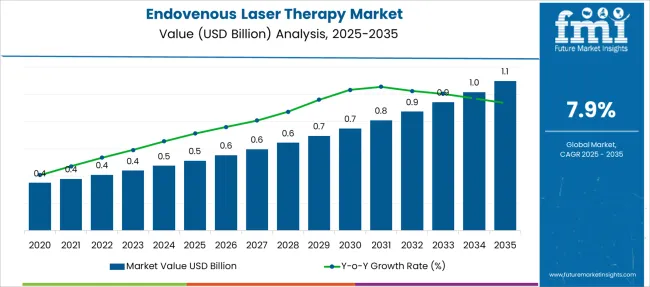
| Metric | Value |
|---|---|
| Endovenous Laser Therapy Market Estimated Value in (2025 E) | USD 0.5 billion |
| Endovenous Laser Therapy Market Forecast Value in (2035 F) | USD 1.1 billion |
| Forecast CAGR (2025 to 2035) | 7.9% |
The endovenous laser therapy market is growing steadily due to the increasing prevalence of chronic venous diseases and the rising preference for minimally invasive treatment options. Advances in laser technology have enhanced the efficacy and safety of endovenous procedures, making them a preferred alternative to traditional surgical methods.
Healthcare providers are adopting these systems to reduce patient recovery time, minimize complications, and improve clinical outcomes. Hospitals remain the primary setting for these procedures due to the need for specialized equipment and trained medical personnel.
Additionally, growing awareness among patients about less invasive treatments and increasing healthcare infrastructure investments support market expansion. The focus on outpatient care and day surgeries also fuels demand. The market growth is expected to be driven by the widespread adoption of endovenous laser systems and the dominance of hospitals as the main end user.
The market is segmented by Product and End User and region. By Product, the market is divided into Endovenous Laser Systems and Endovenous Laser Fibers. In terms of End User, the market is classified into Hospitals, Ambulatory Surgical Centers, and Specialized Clinics. Regionally, the market is classified into North America, Latin America, Western Europe, Eastern Europe, Balkan & Baltic Countries, Russia & Belarus, Central Asia, East Asia, South Asia & Pacific, and the Middle East & Africa.
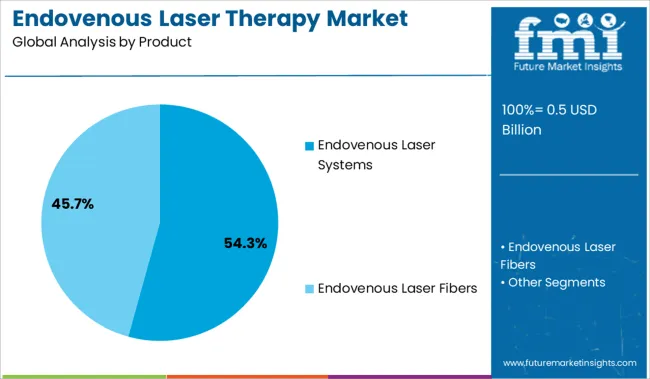
The Endovenous Laser Systems segment is projected to hold 54.3% of the market revenue in 2025, maintaining its leading position among product types. This growth has been driven by the enhanced precision and effectiveness of laser systems in treating varicose veins and related conditions. The minimally invasive nature of these systems reduces patient discomfort and accelerates healing compared to conventional surgery.
Technological improvements have increased the range of wavelengths and fiber designs available, improving treatment customization for different vein sizes. These systems are preferred by physicians for their ability to deliver consistent and reproducible outcomes.
As awareness of the benefits of laser therapy grows, the Endovenous Laser Systems segment is expected to continue its dominance.
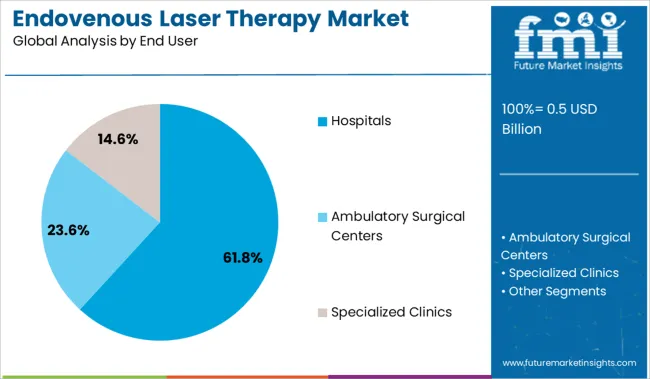
The Hospitals segment is projected to account for 61.8% of the market revenue in 2025, leading among end users. This segment’s growth is supported by hospitals’ capabilities to offer comprehensive vascular treatment services with advanced medical technology and skilled specialists.
Hospitals provide the infrastructure needed for preoperative evaluation, the procedure itself, and postoperative care. The adoption of endovenous laser therapy in hospitals aligns with the trend toward minimally invasive outpatient procedures that reduce hospital stays.
Additionally, hospitals often act as referral centers for vascular specialists, further consolidating patient volumes. With continued investment in healthcare infrastructure and increased patient preference for hospital-based treatments, the Hospitals segment is expected to maintain its lead.
| Particulars | Details |
|---|---|
| H1, 2024 | 7.25% |
| H1, 2025 Projected | 7.83% |
| H1, 2025 Outlook | 7.53% |
| BPS Change - H1, 2025 (O) - H1, 2025 (P) | (-) 30 ↓ |
| BPS Change - H1, 2025 (O) - H1, 2024 | (+) 28 ↑ |
The comparative analysis and market growth rate of the global endovenous laser therapy market as studied by Future Market Insights’ will show a negative BPS growth in the H1-2025 outlook as compared to the H1-2025 projected period by 30 BPS.
The market is subject to changes as per macro and industry standards. Factors that affect the market dynamics are related to side effects and postoperative complications.
Moreover, the availability of alternative treatments such as traditional vein surgery affects the adoption of endovenous laser therapy. All these factors are responsible for the observed reduction in the BPS values.
However, a positive BPS growth is expected in H1-2025 over H1- 2024 duration with 28 Basis Point Share (BPS). The reasons for the surge in the market is due to high prevalence of varicose veins, the availability of user-friendly featured devices, and the adoption of minimally invasive devices.
Additionally, top players are constantly launching new and improved products and increasing funding in research and development to propel market growth.
Sales of endovenous laser therapy grew at a CAGR of 6.7% between 2020 and 2024.
The rapid increase in the number of patients suffering from varicose veins is one of the key factors anticipated to strengthen the demand and growth of the endovenous laser therapy market. Varicose veins are more common in female patients than in male patients.
In addition, rising cases of varicose veins because of the growing aging population is a common problem worldwide. Shifting towards an unhealthy lifestyle can as well lead to varicose veins.
Some other factors creating a positive impact on the market are the fast and effective procedures offered by endovenous laser therapy for the treatment of varicose veins over traditional vein surgery. The procedure needs only local anesthesia with minimal discomfort.
Also, the therapy has a high success rate. These factors increase the adoption of endovenous laser therapy which in turn leads to market growth.
In addition, the major manufacturers present in the global market are focusing on offering user-friendly equipment to end users for reducing the chances of manual errors. Devices with features such as an intuitive user interface with portable devices & lesser buttons, data storage, and faster procedure setup are being offered by manufacturers to attract a larger customer base.
This is anticipated to boost the adoption and demand for the endovenous laser therapy market.
The availability of alternative treatments and the side effects associated with endovenous laser therapy are the major factors anticipated to hamper the growth of the market.
Although endovenous laser therapy is a simple and safe way to treat varicose veins, the possibility of suffering from potential but rare side effects cannot be neglected.
The most common side effect of this treatment method is aching and bruising at the puncture site, temporary numbness in the leg, or pain or inflammation in the length of the vein treated which may persist for up to 2 weeks in some patients.
Also, besides endovenous laser therapy, there are many other medical procedures available to treat varicose veins which will restrain the growth of this market.
Treatment options such as sclerotherapy, high ligation, and vein stripping are being implemented to treat varicose veins across the globe. Although there are no oral or topical drugs of proven efficacy for venous disease, still many patients rely on drugs for the management and treatment of varicose veins.
These options reduce the adoption of endovenous laser therapy thus hindering market growth.
The COVID-19 pandemic was projected to have a major impact on the development of the studied market. The market observed a huge slowdown in its growth due to the spread of the Covid-19 pandemic worldwide.
Along with the effects of COVID-19 on public health, there was the subsequent effect of near? universal cancelation and disruption of surgical facilities, which had unprecedented effects on patients with surgical conditions and surgical services.
However, in the post-COVID-19 situation, the increasing cases of varicose veins were expected to drive the market. As recovery began in 2024, key players started to improve their positions through capacity utilization, production expansion, and collaborations with other players in 2024.
Also, hospitals and ambulatory surgical centers were focusing on maintaining covid norms in order to prevent infections while performing surgeries.

The USA accounted for nearly 90.5% of the North American endovenous laser therapy market in 2024. The growth can be attributed to the increasing number of cases of varicose veins.
For example, as per the American Vein and Lymphatic Society, about 0.4 million people suffer from varicose veins in 2020, in the USA Also, the increase in the prevalence of obesity and increasing FDA approvals are expected to drive the sales in the USA Furthermore, the technological advancement in laser therapy and favorable reimbursement scenario are some other factors responsible for the growth of the market.
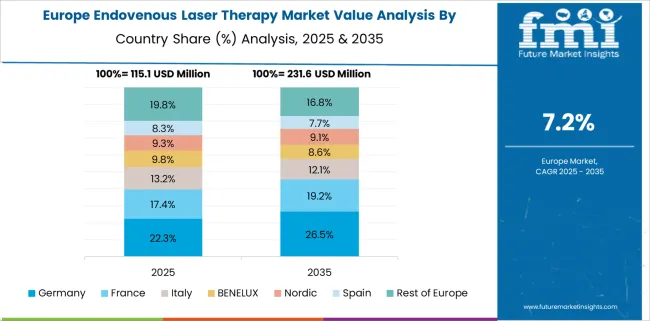
Germany accounted for 19.8% of the Europe endovenous laser therapy market in Europe in 2024. The rising availability of technologically advanced equipment in European countries like Germany is expected to drive the sales of the market during the forecast period.
In Germany, most healthcare treatment is provided under the public health systems, and the government is deliberately providing subsidies for healthcare treatment. This is an additional factor leading to market growth in Germany. Moreover, increasing awareness regarding the treatment of varicose veins is expected to fuel the demand in Germany.
The endovenous laser therapy market in China was worth USD 0.5 Million in 2024.
The increase in the need for varicose veins treatment in China due to the growing number of people suffering from varicose veins is expected to lead to a rise in the utilization of endovenous laser systems in China, thus resulting in the growth of the market in China. In addition, rapid development in laser technology in the country with an increasing number of local players in China is leading to market development during the forecast period.
Demand for endovenous laser therapy in Japan is expected to rise at an impressive 7.0% CAGR over the forecast period.
The need for early treatment for varicose veins due to the rising geriatric population in Japan is expected to be the primary factor driving the market in the country. Moreover, increasing government initiatives to increase awareness regarding laser therapy is likely to support the growth of the market. An increasing number of product launches in the country will add to the development of the market.
India accounted for 25.3% of the endovenous laser therapy market in Asia Pacific in 2024. The demand for the market in India is due to the rise in the obese population in the country.
Obesity is one of the factors responsible for varicose veins. Unhealthy diet and urbanization of lifestyle lead to obesity. Thus, a rise in the obese population is likely to drive the market in India. In addition, developed infrastructure and increasing disposable income in India are some factors increasing the adoption of laser treatment in the country.
By product, the endovenous laser systems segment held the maximum share of 92.0% in 2024, expanding at a rapid rate during the forecast period.
The increase in demand for early treatment due to the rising number of varicose veins cases and the availability of technologically advanced products are primary factors responsible for the growth of the segment over the forecast period.
Moreover, an increase in Research and Development expenditure in several countries is leading to an increase in the number of product launches with advanced features which in turn is increasing the adoption of endovenous laser systems for the treatment of varicose veins.
Due to the increasing need for minimally invasive procedures and minimal discomfort from procedures, several patients are adopting laser therapy over traditional treatments, which is adding to segment growth.
By end user, the ambulatory surgical center's segment held the maximum share of 36.2% in 2024, expanding at a rapid rate during the forecast period due to the increasing adoption rate of endovenous laser therapy in ASCs as it is a minimally invasive procedure and is completed in approximately 30-45 minutes.
Furthermore, the continuous innovations in the medical industry are leading to more and more procedures being performed in an outpatient setting rather than in hospitals. In recent years, the number of ambulatory surgical centers has risen due to a rise in demand from the major players in surgical care. physicians, patients, and insurers.
In addition, over 50% of all outpatient surgeries were performed in ASCs (ambulatory surgery centers) in 2020, which is expected to rise by 6-7% as per the Ambulatory Surgery Center Association and ASCA Foundation. This is expected to lead to the development of the segment.
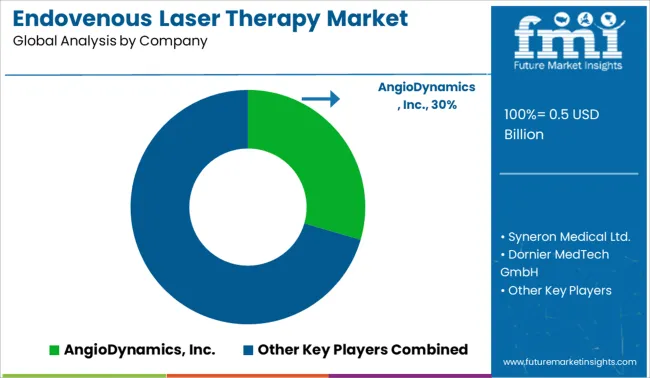
Companies operating in the endovenous laser therapy market are fragmented by nature, with a large number of global and local competitors. These players are involved in a number of strategic alliances.
The product launch, FD approval, and acquisition accelerate the manufacturer’s strategy to capitalize on the market share and capture a significant share of the market. Some of the recent instances include:
| Attribute | Details |
|---|---|
| Forecast Period | 2025 to 2035 |
| Historical Data Available for | 2020 to 2024 |
| Market Analysis | USD Million for Value and Volume in Units |
| Key Countries Covered | The USA, Canada, Germany, The UK, France, Italy, Spain, BENELUX, Russia, China, Japan, South Korea, India, Thailand, Malaysia, Indonesia, Australia, New Zealand, GCC Countries, Turkey, South Africa |
| Key Segments Covered | Product, End User, and Region |
| Key Companies Profiled | AngioDynamics, Inc.; Syneron Medical Ltd.; Dornier MedTech GmbH; Alma Lasers Ltd.; Alna-Medical system GmbH; LSO Medical; Wontech Co., Ltd.; intros Medical Laser GmbH; Energist Ltd. |
| Report Coverage | Market Forecast, Competition Intelligence, DROT Analysis, Market Dynamics and Challenges, Strategic Growth Initiatives |
| Customization & Pricing | Available upon Request |
The global endovenous laser therapy market is estimated to be valued at USD 0.5 billion in 2025.
The market size for the endovenous laser therapy market is projected to reach USD 1.1 billion by 2035.
The endovenous laser therapy market is expected to grow at a 7.9% CAGR between 2025 and 2035.
The key product types in endovenous laser therapy market are endovenous laser systems, _diode lasers, _yag lasers, endovenous laser fibers, _bare tip laser fibers, _radial tip laser fiber and _gold tip laser fiber.
In terms of end user, hospitals segment to command 61.8% share in the endovenous laser therapy market in 2025.






Full Research Suite comprises of:
Market outlook & trends analysis
Interviews & case studies
Strategic recommendations
Vendor profiles & capabilities analysis
5-year forecasts
8 regions and 60+ country-level data splits
Market segment data splits
12 months of continuous data updates
DELIVERED AS:
PDF EXCEL ONLINE
Laser-Assisted Smart Lathes Market Size and Share Forecast Outlook 2025 to 2035
Laser Drilling Equipment Market Size and Share Forecast Outlook 2025 to 2035
Laser Transverse Mode Teaching Instrument Market Forecast and Outlook 2025 to 2035
Laser Welding Equipment Market Forecast and Outlook 2025 to 2035
Laser Welding Market Size and Share Forecast Outlook 2025 to 2035
Laser Ablation Systems Market Size and Share Forecast Outlook 2025 to 2035
Laser Measurement Integrating Sphere Market Size and Share Forecast Outlook 2025 to 2035
Laser Safety Cloths Market Size and Share Forecast Outlook 2025 to 2035
Laser Dazzler Market Size and Share Forecast Outlook 2025 to 2035
Laser Cable Marking Market Size and Share Forecast Outlook 2025 to 2035
Laser Cladding Market Size and Share Forecast Outlook 2025 to 2035
Laser Marking Equipment Market Size and Share Forecast Outlook 2025 to 2035
Laser Cutting Machines Market Size and Share Forecast Outlook 2025 to 2035
Laser Wire Marking Systems Market Size and Share Forecast Outlook 2025 to 2035
Laser Photomask Market Size and Share Forecast Outlook 2025 to 2035
Laser Measuring Instrument Market Size and Share Forecast Outlook 2025 to 2035
Laser Welding Machine Market Size and Share Forecast Outlook 2025 to 2035
Laser Technology Market Size and Share Forecast Outlook 2025 to 2035
Laser Interferometer Market Size and Share Forecast Outlook 2025 to 2035
Laser Safety Glasses Market Growth – Trends & Forecast 2025 to 2035

Thank you!
You will receive an email from our Business Development Manager. Please be sure to check your SPAM/JUNK folder too.
Chat With
MaRIA